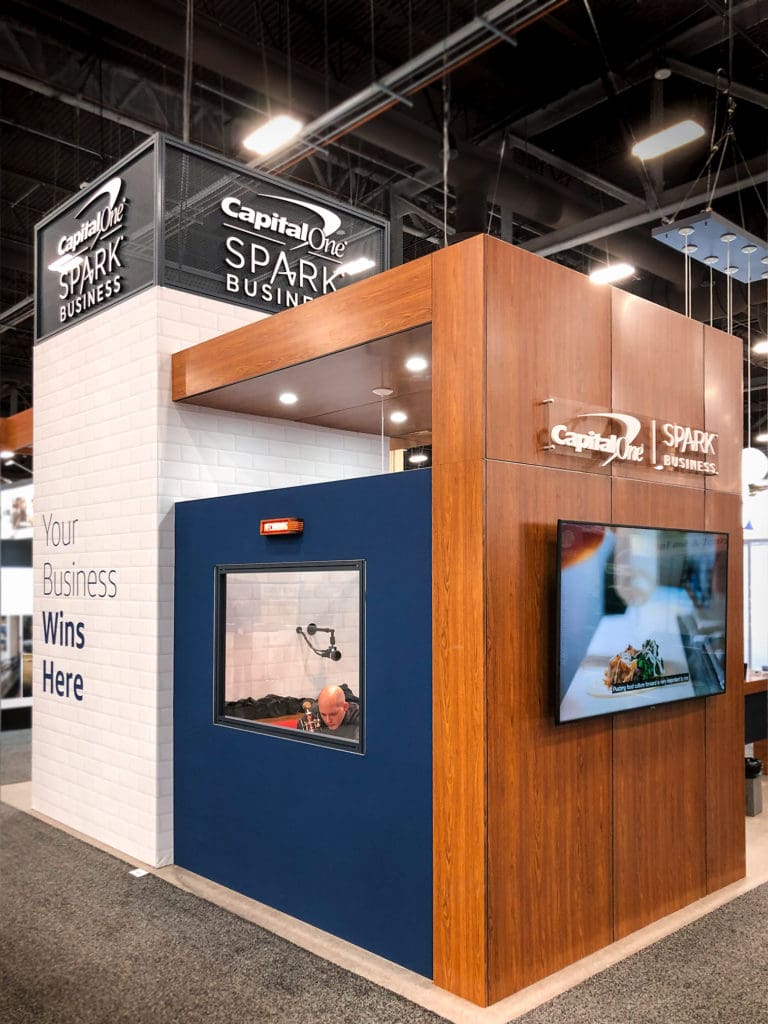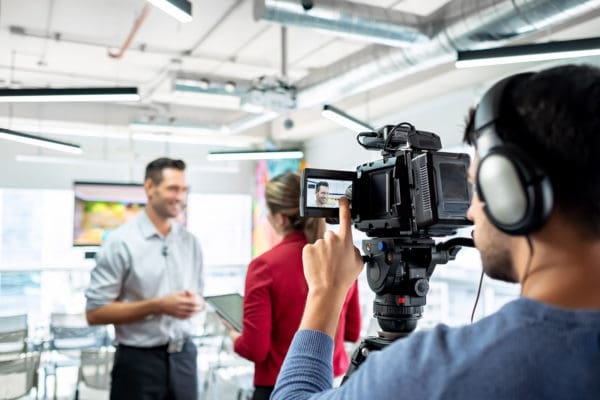In today’s event-driven world, mastering trade show video best practices is key to having a show-stopping exhibit booth. Adding in-booth video content to your exhibit design will capture attendees, drive foot traffic, and build brand recognition.
Video is an important strategy for increasing brand visibility as well as engagement at trade shows, making your booth stand out and perform its best. Whether you’re showing product demos, brand stories, or interactive videos, using video on the show floor has become a powerful way to engage potential customers and generate leads.
Why Do Trade Show Video Best Practices Matter?
Capturing customer attention at a trade show is valuable for any company. With thousands of attendees walking past multiple booths, your trade show video content can make the crucial first impression to get their attention.
According to Statista, nearly 90% of people in the U.S. who use the internet watch videos online. Video is a growing medium of communication, but not all video is created equal. Attendees take 3–10 seconds to walk past a booth before they decide whether to stop. That’s why it’s critical to make an immediate visual impact.
Imagine this: would you rather listen to a long, boring speech about a product or watch a dynamic video of sparks flying off machinery or ships launching? Most attendees prefer engaging, visually stimulating content that gets the message across quickly. Poor quality or irrelevant videos can harm your brand, have attendees overlook your booth, or cause people to leave with the wrong impression.
By contrast, a strong brand presence in your video reinforces brand recognition and tells a cohesive story, so your message resonates with attendees. Make sure your video delivers clear and simple messages to all attendees. Use subtitles or captions to overcome noise and language barriers and get your message across.
Given the fast pace of trade shows, every element of your video production must be precise and high-res to make an impact. Understanding and following trade show video best practices ensures your video content resonates with your target audience and complements your overall trade show display strategy.
Booth Design and Layout: Setting the Stage for Video Success
A well-designed trade show booth is the foundation for your trade show video to shine. The layout and visual appeal of your booth are key to drawing in attendees and getting your video content noticed. Consider these tips:
- Start by placing your video display in a prominent location—ideally at eye level and facing the main flow of foot traffic—so attendees can’t help but see your show video as they walk by.
- Lighting is another important factor; make sure your video display is well-lit without glare and the screen is easy to see.
- Consider the overall flow of your booth to allow attendees to move freely and interact with your team and your video content.
- Add interactive elements like touchscreens, virtual reality, or motion-activated displays so your booth becomes a destination on the show floor.
These elements not only enhance your video content, but also encourage attendees to engage with your brand in a memorable way. By focusing on a visually appealing and interactive booth design, you set the stage for your trade show video to capture attention, engage visitors, and create an impression that encourages further exploration of your products or services.
8 Trade Show Video Best Practices to Know
Your brand deserves the best introduction at any trade show. Creating engaging content is key to stopping and retaining attendee attention at your booth. While video production may seem daunting, follow these expert tips to create engaging, high-quality trade show video content that stops attendees and enhances your booth.
1. Hook Your Audience
The first few seconds of your trade show video are critical to stopping attention on the busy show floor. Follow these best practices to hook your audience with in-booth video content:
- Use high-res visuals, dynamic animations, and motion design to create a hook that gets visitors in. High-quality video displays show professionalism and build trust in your company’s offerings.
- Most attendees prefer engaging, visually stimulating content that gets the message across quickly. To maximize message retention and brand impact, it’s essential to create videos that are compelling enough to be watched by attendees in the fast-paced trade show environment.
- Don’t overwhelm visitors with numbers or data. Instead, focus on emotional appeal by showing action shots or narratives that relate to your audience’s pain points. This will capture attention and get attendees to talk to your team members for deeper conversations.
2. Simplify Your Message
Once you have an attendee’s attention, keep your message simple and concise. Trade show attendees have only a short window to absorb information, so avoid cluttered visuals or long text.
Videos should also be short and concise. Keeping in-booth video content short is key to maintaining attendee engagement as shorter videos (generally under 2 minutes) are more effective at capturing interest without overwhelming viewers. Use bold taglines and minimal on-screen text that matches your brand colors to reinforce your company’s messaging.
Remember, your video content should complement—not compete with—your team members’ interactions. Avoid wordy voiceovers or too much detail that can distract both your staff and visitors. Instead, use images and simple messaging to invite attendees to engage with your booth.
3. No Unnecessary Sounds

Trade show floors are noisy environments. Voiceovers or music with lyrics can get lost in the noise and be hard to hear. If you do use sound, opt for instrumental music without lyrics and keep it subtle so you don’t irritate your guests or your staff.
One of the key trade show video best practices is to ensure your video still works with the sound off. Adding subtitles is highly recommended to maintain clarity. This way, your in-booth video content remains accessible and engaging regardless of the noise level.
4. Make Interactive In-Booth Video Content
Adding interactive elements to your trade show video content can turn your booth into an experience that stops attendees. Touchscreen monitors, motion-sensing displays, and augmented reality features invite visitors to interact with your brand at their own pace. Unlike passive watching, interactive content encourages attendees to engage actively and get deeper insights into your customers.
If budget constraints limit advanced technology, consider using visitors’ mobile devices. Add QR codes to your video displays that allow attendees to access additional content or promotional materials on their smartphones. This not only extends engagement beyond the show floor, but also supports lead generation and data-driven insights.
Preloaded USB drives with your trade show video content can also be a great piece of swag that reinforces your message after the event.
5. Vary Your Video Loop
Since trade show videos play on a loop throughout the event, it’s key to mix up the style and pace of your content. Repetitive in-booth video content can bore attendees, so mix up animations, moods, and speeds to keep your booth fresh and engaging.
Consider creating multiple video loops that play in sequence. Five 2-minute videos are better than one 30-second clip on repeat. Seamless transitions between videos in one file can avoid awkward pauses and look professional on large displays or video walls.
Also, include highlight reels in your video loop to showcase key moments from past events. This extends the impact of your trade show presence after each event through ongoing marketing and social media engagement.
6. Let Them Come to You

Your trade show video content should be an invitation to attendees to come into your booth without feeling intrusive. Large LED video wall booths or screens visible from a distance can generate excitement and attract more visitors.
Video content provides a non-threatening way for new visitors to learn about your company and products and ease into conversations with your team members. This built-in sales funnel effect increases foot traffic and encourages more meaningful interactions on the show floor.
7. Know the Cost of Trade Show Video Content
Creating effective trade show video content doesn’t have to cost an arm and a leg. With today’s technology, even high-quality smartphone videos featuring product demos or customer testimonials can engage attendees. Small screens are an affordable and portable way to display in-booth video content but may not attract as much attention as large displays like video walls.
Investing in video production is cost effective in the long run, as videos can be repurposed for email campaigns, social media, and future events. Compared to traditional promotional materials, videos leave a longer lasting impression, so they’re a smart investment for companies that attend trade shows regularly.
8. Maximize Social Media
To get the most out of your trade show video best practices, integrate your video content with your social media strategy throughout the event.
Before the Show
Before the event, use your videos in online ads to build anticipation and brand awareness.
Use live streaming during the event to engage remote audiences and extend your trade show presence beyond the booth. Live streaming product demos or Q&A sessions in real time can increase interaction and reach a wider audience through your social media channels.
Use YouTube for pre-show teasers, post-show highlight reels, and ongoing engagement to keep your audience interested before, during, and after the event.
During the Show
During the show, include hashtags and social media handles on your in-booth video content to encourage attendees to share their experience. This social proof can generate excitement and extend your networking reach.
After the Show
After the event, engage with leads by responding to social media interactions and following up with potential customers. Integrating these strategies helps build brand awareness and gets the most out of your trade show video. This ongoing engagement helps solidify relationships and generates leads for your next trade show.
Lead Generation and Conversion: Turning Viewers into Prospects
A good trade show video does more than just grab attention—it’s a lead generation and conversion tool. To turn viewers into prospects, your video content should have a clear and actionable call-to-action (CTA). Whether you’re asking attendees to visit your website, sign up for a demo, or connect with a team member, make sure your CTA is easy to follow and find on the screen.
Interactive elements like QR codes in your show video or on-screen prompts to use mobile devices can make it easy for attendees to access more information or exclusive offers. By providing valuable insights and addressing the pain points of your target audience, your video content builds trust and positions your company as a thought leader in your industry.
Use data-driven insights by tracking which interactive elements are most popular and following up with engaged attendees after the event. This not only generates leads, but allows you to refine your video strategy for even better results at future trade shows.
Measuring Success and ROI: Proving the Value of Your Trade Show Videos
To prove your trade show video is delivering value, you need to measure its success using clear metrics.
- Start by tracking key performance indicators like video views, engagement rates, and number of leads generated during the event. Analytics tools can help you see how attendees are interacting with your video content and provide valuable data to inform your ongoing video marketing strategy.
- Set specific goals for your trade show video—whether it’s increasing foot traffic to your booth, social media engagement, or sales conversions. By comparing these outcomes to your initial goals, you can calculate the return on investment (ROI) and show your stakeholders the impact of your video strategy.
- Don’t forget to consider both quantitative and qualitative feedback. Metrics like foot traffic, social media mentions, and post-event lead generation all contribute to a full picture of your show video’s effectiveness.
By continuously analyzing and optimizing your video content, you’ll get the most out of your trade show investment and see stronger brand awareness, more engaged attendees, and measurable business growth.
Looking for a New Trade Show Booth?
Ready to take your trade show to the next level with video content? Cardinal Expo can help. As a full-service trade show and exhibit company with nearly 30 years of experience, we create custom trade show booths that match your brand and goals.
From high-definition video walls to interactive displays, we have everything you need to grab attendees’ attention and generate more leads. Call us today at (800) 695-3452 or contact us below to find out how easy it is to incorporate video into your next trade show booth and make an impact with your audience.
Contact Us Today
We at Cardinal Expo are here to answer any questions you may have, provide you with additional information, and create an effective solution for your exhibit needs.
"*" indicates required fields


